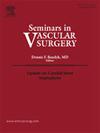老年患者腹股沟下外周动脉疾病的开放血运重建术:范围综述
IF 2.4
3区 医学
Q1 PERIPHERAL VASCULAR DISEASE
引用次数: 0
摘要
外周动脉疾病(PAD)是老年患者中一种常见的衰弱性疾病,常导致严重肢体威胁缺血(CLTI)和大面积截肢。虽然血管内介入术的围手术期风险较低,但由于其在复杂疾病模式下的耐久性和良好的通畅性,也应考虑开放手术血运重建术。年龄本身不能决定手术的适宜性;相反,候选资格取决于虚弱,功能状态,合并症和解剖学考虑。当代全球指南支持以患者为中心的方法,将这些多维因素整合在一起。本综述将评估70岁以上患者的开放式腹股沟下血运重建术与血管内入路的结果,并讨论这些结果如何与当代指南和临床决策范例相一致。一名独立审稿人筛选PubMed,以确定同行评议的观察性研究和随机对照试验(2004-2024),涉及70岁接受开放式腹股沟下血管重建术的患者。关键词包括“腹股沟下PAD”、“开放式血供重建术”和“老年人”。提取的关键数据包括围手术期发病率、死亡率、移植物通畅、肢体保留以及相对于血管内策略的有效性。通过参考文献检索,共检索到1574篇文献。然后,我们筛选了这些文章,并评估了265篇全文文章的合格性。排除后,19篇全文文章入选。纳入了19项符合条件的研究。老年人开放血运重建术30天死亡率为2% ~ 5%,肢体保留率为80% ~ 90%。与血管内技术相比,开放旁路手术的再介入率较低,长期通畅性较好,特别是当使用自体静脉时。血管内手术因其良好的围手术期特点而被高危或体弱患者所青睐。虚弱、功能独立和导管可用性成为手术成功的关键决定因素。开放式腹股沟下血运重建术仍然是一种可行的选择,通常是老年PAD患者的首选。决策时应优先考虑生理年龄、解剖适应性和患者偏好,而不是实际年龄。多学科、指南驱动的方法可以优化结果,降低风险,并在这一不断增长的人群中保持肢体功能和生活质量。本文章由计算机程序翻译,如有差异,请以英文原文为准。
Open revascularization for infrainguinal peripheral arterial disease in elderly patients: A scoping review
Peripheral arterial disease (PAD) is a prevalent and debilitating condition in elderly patients, often leading to critical limb threatening ischemia (CLTI) and major amputations. While endovascular interventions are usually preferred for their lower perioperative risk, open surgical revascularization should also be considered due to its durability and superior patency in complex disease patterns. Age alone does not determine suitability for surgery; rather, candidacy hinges on frailty, functional status, comorbidities, and anatomical considerations. Contemporary global guidelines endorse a patient-centered approach that integrates these multidimensional factors. This scoping review will evaluate the outcomes of open infrainguinal revascularization in patients over 70, compared to endovascular approaches, and discuss how these findings align with contemporary guidelines and clinical decision-making paradigms. A scoping review was performed using one independent reviewer who screened PubMed to identify peer-reviewed observational studies and randomized controlled trials (2004-2024) involving patients aged >70 undergoing open infrainguinal revascularization. Keywords included “infrainguinal PAD,” “open revascularization,” and “elderly.” Key data extracted included perioperative morbidity, mortality, graft patency, limb salvage, and comparative effectiveness against endovascular strategies. A total of 1,574 articles were identified through reference search. We then screened these articles and assessed 265 full-text articles for eligibility. After exclusion, 19 full-text articles were selected for final inclusion. Nineteen eligible studies were included. Open revascularization in the elderly demonstrated 30-day mortality rates of 2% to 5% and 80% to 90% limb salvage rates in patients. Compared to endovascular techniques, open bypass yielded lower reintervention rates and superior long-term patency, especially when an autologous vein was used. Endovascular procedures were favored in high-risk or frail patients for their favorable perioperative profile. Frailty, functional independence, and conduit availability emerged as key determinants of surgical success. Open infrainguinal revascularization remains a viable and often preferable option for select elderly PAD patients. Decision-making should prioritize biological age, anatomical suitability, and patient preferences over chronological age. A multidisciplinary, guideline-driven approach can optimize outcomes, minimize risk, and preserve limb function and quality of life in this growing population.
求助全文
通过发布文献求助,成功后即可免费获取论文全文。
去求助
来源期刊
CiteScore
3.50
自引率
4.00%
发文量
54
审稿时长
50 days
期刊介绍:
Each issue of Seminars in Vascular Surgery examines the latest thinking on a particular clinical problem and features new diagnostic and operative techniques. The journal allows practitioners to expand their capabilities and to keep pace with the most rapidly evolving areas of surgery.

 求助内容:
求助内容: 应助结果提醒方式:
应助结果提醒方式:


